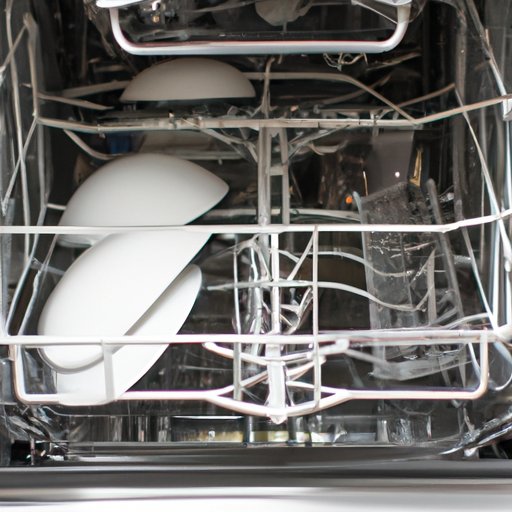
Introduction
Dishwashers are essential appliances in modern homes, making it convenient to clean and sanitize dishes, utensils, and cookware. However, when the dishwasher fails to drain, it can be frustrating and time-consuming. In this article, we will walk you through the steps on how to drain a dishwasher and provide troubleshooting tips for common problems.
Step-by-Step Guide
Preparation
Before beginning any dishwasher draining procedure, you will need the following tools:
- Screwdriver
- Bucket or large container
- Gloves
- Cleaning solution made specifically for dishwashers
It is important to put on your gloves and observe safety precautions before starting the process to avoid potential injuries.
Steps
Step 1: Turn off the Power
Start by disconnecting the power supply to the dishwasher. You can either turn off the circuit breaker or unplug the dishwasher from the outlet.
Step 2: Remove the Standing Water
Using a sponge or a cup, remove the standing water in the dishwasher. Place it in a bucket and dispose of it properly in the sink or toilet.
Step 3: Locate and Disassemble the Dishwasher’s Drain
Locate the dishwasher’s drain under the sink. Remove the drain cover or grate to access the drain pipe. Disconnect the drain hose and the clamps holding it in place using a screwdriver. Remove any debris, such as food particles or grease, using a pipe cleaner or a similar tool.
Step 4: Clean the Drain
Next, pour the cleaning solution into the drain and let it sit for a few minutes. Then, use a pipe cleaner or a brush to clean the drain from the inside. Remove any accumulated debris, ensuring that the drainpipe is clear of any blockages.
Step 5: Reassemble the Dishwasher’s Drain
After cleaning the drain, reassemble the dishwasher’s drain hose, ensuring that it is securely fastened to prevent leaks. Reattach the clamps and the drain cover or grate.
Troubleshooting Tips
What to Do If the Dishwasher Still Won’t Drain
If the dishwasher still won’t drain after following the above steps, check for the following:
- A clogged filter
- A blocked or kinked drain hose
- A faulty garbage disposal
Refer to the next section on Common Problems and Solutions for detailed solutions.
Preventative Measures to Take in the Future
To prevent future blockages, consider taking the following measures:
- Cleaning the filters regularly
- Running hot water before starting the dishwasher
- Avoiding overloading the dishwasher
Common Problems and Solutions
Clogged Filters
If the dishwasher still won’t drain properly, the filters may be clogged. Check the manufacturer’s instructions on how to locate and clean the filters. Remove any debris and rinse the filters under running water. Reinstall the filters and test the dishwasher.
Garbage Disposal
Another potential issue is a clogged garbage disposal. Check the garbage disposal for any clogs or blockages. Use a flashlight to look down the disposal and remove any objects that may be blocking the blades. Run water through the disposal to ensure it’s clear.
Drain Hose
If the drain hose is bent or kinked, it may cause the dishwasher not to drain properly. Straighten out the hose and check it for blockages. If the hose is damaged, replace it with a new one.
Other Potential Problems
If none of the above solutions work, there may be a more serious issue with the dishwasher’s pump, motor, or timer. In such cases, it is best to seek professional help for repair or replacement.
Pros and Cons of DIY vs. Professional Help
DIY
Advantages
- Cost-saving
- Convenience
Disadvantages
- Lack of expertise
- Potential for causing more damage
Professional Help
Advantages
- Expertise and knowledge
- Warranty and guarantees
Disadvantages
- Costly
- Scheduling constraints
Preventative Maintenance Tips
Cleaning the Filters Regularly
Cleaning the filters at least once a month prevents blockages and ensures proper functioning of the dishwasher.
Running Hot Water Before Starting the Dishwasher
Running hot water before starting the dishwasher clears the drain and enables efficient operation of the dishwasher.
Avoiding Overloading the Dishwasher
Overloading the dishwasher can damage the water jets and heating elements and cause blockages. Always load the dishwasher according to the manufacturer’s instructions.
Product Reviews
Drain Hoses
Top-rated drain hoses include the Eastman 91218 Universal-Fit Corrugated Dishwasher, GE WD24X10065 Genuine OEM Drain Hose and Supply Line Assembly, and the LASCO 16-1904 Dishwasher Drain Hose.
Garbage Disposals
The top-rated garbage disposals include InSinkErator Evolution Excel 1.0 HP Continuous Feed, Waste King L-8000 Legend Series 1.0 HP Continuous Feed, and Moen GXS75C GX Series ¾ hp Garbage Disposal.
Air Gaps
The top-rated air gaps include the Kohler K-9110-VS Air Gap, Westbrass D200-1-20 Air Gap Cap, and Delta Faucet 72020-SS Accessory Air Gap.
Conclusion
Recap of the Article
We have explored how to drain a dishwasher using a step-by-step guide and provided troubleshooting tips for common problems. We have also discussed the pros and cons of DIY vs. professional help and given preventative maintenance tips to ensure proper functioning of the dishwasher.
Final Advice
Always follow safety precautions when handling appliances and repairing or replacing parts. If you are not comfortable with DIY repairs, seek professional help. In addition, maintain good dishwasher hygiene by cleaning it regularly and loading it according to the manufacturer’s instructions.
Call to Action
Put these tips into action and keep your dishwasher running smoothly without any drainage issues.





